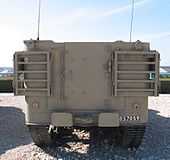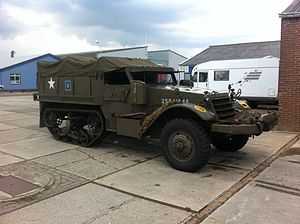M5 Half-track
| M5 Half-track | |
|---|---|
|
A preserved M5 Half-track | |
| Type | Half-track armored personnel carrier |
| Place of origin | United States |
| Service history | |
| In service | 1941–1960? |
| Used by | see list |
| Wars | World War II, Korean War, Suez Crisis, Arab-Israeli War of 1948, and others |
| Production history | |
| Designer | International Harvester |
| Designed | 1940–1942 |
| Manufacturer | International Harvester |
| Produced | 1943–1945? |
| Number built | ~5,000 |
| Specifications (with winch[1]) | |
| Weight | 18,900 lb (8,600 kg) loaded |
| Length | 12 feet 5 1⁄16 inches (3.79 m) |
| Width | 7 feet 3 1⁄2 inches (2.22 m) |
| Height | 7 feet 4 inches (2.24 m) overall |
| Crew | 3+10 troops |
|
| |
| Engine |
IHC Red-450-B 141 hp (105 kW) |
| Suspension |
Beam axles on leaf springs (front) tracks (rear) |
| Fuel capacity | 60 US gal (230 l)[2] |
Operational range | 125 mi (201 km)[2] |
| Speed | 42 mph (68 km/h) |
The Carrier, Personnel Half-track M5, also known as the M5 Half-track, was an American armored personnel carrier from World War II. It was produced in the United States by International Harvester as a supplement to production of the M3 Half-track. It was supplied to Allied nations (the British Commonwealth, France, and the Soviet Union) under the Lend-Lease. After the war it was leased to many countries in the NATO.
The M9 Half-track was the same vehicle but with a different internal layout to fulfill the same purpose as the M2 Half Track Car.
Development

In 1942, the U.S. faced a demand for a greater supply of M3 half tracks to the Allies and the existing manufacturers could not provide these. International Harvester could build them but changes in components and construction were necessary. Due to a lack of face-hardened armor, homogenous armor was used. Although thicker at 5/16 inch to the M3's 1/4 inch, it was effectively less protection – armor piercing rifle caliber bullets could penetrate it at 300 yds rather than 200 yds for the M3.[3] At the same time IH was to produce a version of the M2 Half Track Car, the M9 Half-track.[4]
Production history
The first production of the M5 were completed in December 1943. Changes to the demand for half-tracks led to reduced orders within the U.S. Army, and the M5 became "limited standard" for the U.S., and most all M5s were sent for Allied use. The added weight of the armor reduced the speed to 42 mph, and range was reduced to 125 mi.[5]
Operators
During the war the majority of M5 (and M9) production went to the United Kingdom, which then passed them on to Commonwealth forces or other allies operating with the British Army such as Free Polish or Free Czech forces. The Soviet Union received supplies directly. In British service they were used as utility vehicles for Royal Engineers units, or to motor battalions instead of 15cwt trucks for towing anti-tank guns.[5]
After the war, half tracks were provided under the Military Aid Program (MAP).[6]
-
 Brazil – Received 20.[6]
Brazil – Received 20.[6] -
 Canada – Received 20[7]
Canada – Received 20[7] -
 Chile – Received 10.[6]
Chile – Received 10.[6] -
 China – Lended from the U.S.[6]
China – Lended from the U.S.[6] -
 Czechoslovakia – Lended from Britain.[6]
Czechoslovakia – Lended from Britain.[6] -
 France – Received 1,196[3]
France – Received 1,196[3] -
 Israel – Acquired in 1948–49 from Europe, and directly from U.S. after 1949.[8]
Israel – Acquired in 1948–49 from Europe, and directly from U.S. after 1949.[8] -
 Mexico – Received two.[6]
Mexico – Received two.[6] -
.svg.png) Nazi Germany – Captured from the U.S.[9]
Nazi Germany – Captured from the U.S.[9] -
 Poland – Lended from Britain.[6]
Poland – Lended from Britain.[6] -
.svg.png) Soviet Union – Received 450 during World War II.[7] Received 401 after the war.[6]
Soviet Union – Received 450 during World War II.[7] Received 401 after the war.[6] -
 United States[10]
United States[10] -
 United Kingdom[6]
United Kingdom[6]
Variants

- M3E2/M5 – An International Harvester half-track. Virtually identical to the M3. The only differences was the thicker armor (up to 20 mm), different engine (IHC RED-450-B), and lower range (125 mi (201 km)). This model was mainly supplied to the Soviet Union, the British Commonwealth, and France. 4,625 were produced.[5]
- M5A1 – M5 with a M49 machine gun mount.[11] It could fit one 0.5 inch (12.7 mm) M2 Browning heavy machine gun, and two 0.3 inch M1919 Browning machine guns.[4] 2,859 were produced.[5]
- M5A2 – Similar to the M3A2, the M5A2 was a combination of the M5 and M9 Half-tracks. This was a project that was never mass produced.[5]
- M9 – Same as the M5, stowage arranged as the M2 Half-track, with access to radios from inside (as opposed to outside) and rear doors, plus pedestal machine gun mount.[4] 2,026 were produced.[5]
- M9A1 – Same as the M9, with ring mount and three machine gun pintles.[4] 1,407 were produced.[12]
- M14 Half-track – A version of the M13 Multiple Gun Motor Carriage, based on the M5. It had two 0.5 in machine guns mounted in a M33 Maxson turret on the rear of the chassis. Several hundred were produced before it was replaced by the M16 MGMC and M17 MGMC. 1,605 were produced.[12]
- M17 Half track – M5 with the same quadruple 0.5 inch machine gun turret as the M16 MGMC. All 1,000 were supplied to the USSR.[13] It saw limited use at end of World War II and was also deployed during the Korean War.[14]
See also
References
Citations
- ↑ "TM-9-2800-1 Standard Military Motor Vehicles". United States Department of War. 1 September 1943. pp. 34–35. Retrieved 31 December 2014.
- ↑ 2.0 2.1 Berndt (1993), p. 152.
- ↑ 3.0 3.1 Zaloga (1994), p. 12.
- ↑ 4.0 4.1 4.2 4.3 Berndt (1993), p. 147.
- ↑ 5.0 5.1 5.2 5.3 5.4 5.5 Hunnicutt (2010), p. 52.
- ↑ 6.0 6.1 6.2 6.3 6.4 6.5 6.6 6.7 6.8 Zaloga (1994), pp. 21–22.
- ↑ 7.0 7.1 Zaloga (1994) p. 13.
- ↑ Zaloga (1994), p. 23.
- ↑ Zaloga (1994), p. 15.
- ↑ Zaloga (1994), p. 3.
- ↑ Berndt (1994), p. 28.
- ↑ 12.0 12.1 Ness (2002), p. 196.
- ↑ Zaloga (1994), p. 39.
- ↑ Green (2014), p. 296.
Bibliography
- Berndt, Thomas (1993). Standard Catalog of Military Vehicles. Iola, WI: Krause Publications. ISBN 0-87341-223-0
- Berndt, Thomas (1994). American Tanks of World War II. Minnesota, MN: MBI Publishing Company. ISBN 0-87938-930-3
- Green, Michael (2014). American Tanks & AFVs of World War II. Oxford, UK: Osprey Publishing. ISBN 1-78200-931-0
- Hunnicutt, R.P. (2010). Half-Track: A History of American Semi-Tracked Vehicles. Navato, CA: Presidio Press. ISBN 0-89141-742-7
- Ness, Leland (2002). Jane's World War II Armored Fighting Vehicles. London, UK: HarperCollins. ISBN 0-00-711228-9
- Zaloga, Steven J. (2004). M3 Infantry Half-Track 1940–73. Oxford, UK: Osprey Publishing. ISBN 1-85532-467-9
External links
| Wikimedia Commons has media related to M3 Halftrack. |
| ||||||||||||||||||
